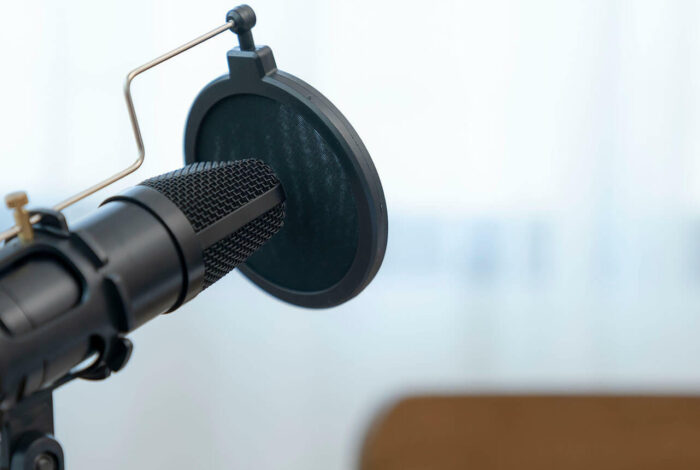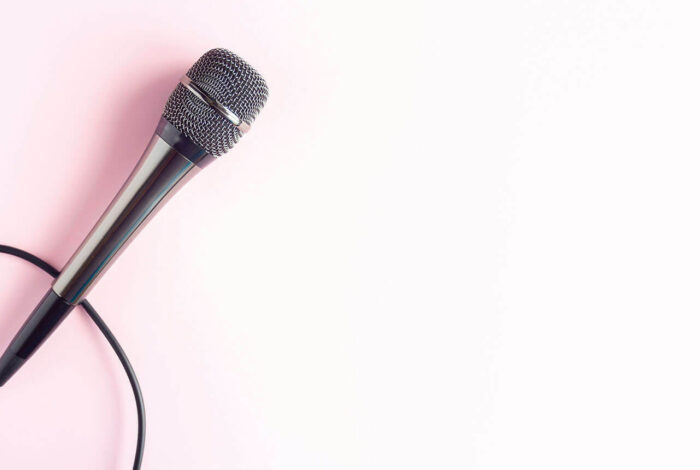Microphone type: Condenser or dynamic?
Condenser microphones are best for:
- Professional studio work.
- Higher quality recordings.
Dynamic microphones are best for:
- Long voice-over recordings.
- Working in a studio that doesn’t have acoustic treatment, or a space that isn’t a professional recording studio.
- Outdoor recording.
Directional type: Cardioid or omnidirectional?
Cardioid
This is a microphone with a one-directional recording capability. It’s suited to voice-overs and other solo voice work, where the vocalist is located in front of the microphone.
Omnidirectional
An omnidirectional microphone records sound from all directions. Unless you have multiple voice actors, this isn’t usually necessary for voice-over recording.
Budget
Although budget is a consideration, don’t assume that the price you pay will dictate the quality you get. It’s well worth researching what’s available. You can start your research into the best microphones for voice-overs here:
Our top 12 best voice-over microphones for 2023
Blue Snowball iCE
- Connection type: USB
- Microphone type: Condenser
- Directional characteristic: Cardioid and omnidirectional
- Price range: Budget
The Blue Snowball iCE microphone provides clear audio quality and enables you to switch between omnidirectional and cardioid recording direction. This enables you to change the way that your recording sounds based on your location or your audio content.
It’s a plug and play microphone, so set-up is easy. The iCE integrates with various devices and software without the need to change settings, so you’re up and running as soon as you’re plugged in.
Audio-Technica AT2020USB+
- Connection type: USB
- Microphone type: Condenser
- Directional characteristic: Cardioid
- Price range: Budget-mid
The Audio-Technica AT2020USB+ has a built-in jack for headphones and volume control. It’s a plug and play model so you can connect it via USB to your computer and record professional-quality sound straight away. It can be easily mounted to your desk or table, enabling you to find the perfect recording position.
The microphone includes an amplifier. This helps cut down on the amount of post-production adjustments necessary. It also allows a good range of vocals to be recorded with low signal noise.
The Plus version of the Audio-Technica AT2020USB+ adds a self-monitoring feature to your set-up.
Heil PR-40
- Connection type: XLR
- Microphone type: Dynamic
- Directional characteristic: Cardioid
- Price range: Mid
The Heil PR-40 has the widest frequency range of the dynamic microphones available from this renowned brand, which makes it particularly suited to voice recording. It’s designed to capture a very natural, unaltered level of sound. This is useful if you need to change the sound qualities of your voice-over recording post-production.
It’s a good-looking unit with a durable build and it has useful features that rival those of more expensive microphones.
Blue Yeti
- Connection type: USB
- Microphone type: Condenser
- Directional characteristic: Cardioid and omnidirectional
- Price range: Budget-mid
A good entry-level microphone with plenty of capability and features for the price. The Blue Yeti produces good sound quality, has a robust build and is easy to set up.
The Blue Yeti has multiple customisable options, so that you can change how your recording sounds. It’s also got a jack for headphones that provide gain and volume adjustments. This gives you a lot more control of the recording directly from the microphone.
Marantz Professional MPM-1000
- Connection type: XLR
- Microphone type: Condenser
- Directional characteristic: Cardioid
- Price range: Budget
A small, lightweight microphone with good sound quality at an affordable price. It’s very portable due to the size, so ideal if you’re not working from the same location every day.
The Marantz Professional MPM-1000 has clear audio capture using a wide-ranging frequency response. This means that you’ll hear every detail in the recording. It has a decent output signal teamed with a flexible tone that works very well with vocals in any range.
Background noise is also eliminated thanks to this microphone’s cardioid polar pattern: Your audience will only hear your voice and not what’s happening behind you.
Rode NT1A
- Connection type: XLR
- Microphone type: Condenser
- Directional characteristic: Cardioid
- Price range: Mid
The Rode NT1A is a firm favourite with voice-over artists. It’s available at an affordable price and has features you usually only find on higher-spec microphones.
It delivers exceptional sound quality and picks up on smaller audible details that other microphones in this price range miss. This gives you the ability to record crystal-clear audio over an impressive vocal range.
Included in the price is a useful shock mount, a mic dust cover and a pop filter, making this microphone excellent value for money.
Shure SM7B
- Connection type: XLR
- Microphone type: Dynamic
- Directional characteristic: Cardioid
- Price range: Mid
This microphone is a really good choice for voice-overs and offers many high-end features at a mid-range price. It has a flat, wide-range frequency response that makes it ideally suited to the human voice. Pop filters also eliminate narration defects, which makes your recording less likely to need editing work.
The switchable frequency filter can put some sparkle into your vocal recording and gives your voice a stage-like quality. It also shields against the electromagnetic hum that can be produced by electrical devices in the vicinity of your studio space. This is a popular all-round microphone, but it’s particularly favoured for voice-overs and over vocal work.
Rode NT-USB
- Connection type: USB
- Microphone type: Condenser
- Directional characteristic: Cardioid
- Price range: Budget-mid
The Rode NT-USB provides superb voice-over recording quality at a reasonable price, which makes it a good choice for many different projects. It doesn’t require any additional software or other equipment to function; you just plug it in and start recording.
The solid, durable design of the unit is well thought out and it comes with a tripod stand, ring mount and pop shield. You can also add a headphone monitor and extra controls if necessary.
The Rode NT-USB has a really good dynamic range, and the sound quality is clear at every recording volume, from a whisper to a shout.
Electro Voice RE-20
- Connection type: XLR
- Microphone type: Dynamic
- Directional characteristic: Cardioid
- Price range: Mid-high
This is an extremely capable dynamic microphone used extensively in the professional voice-over industry to produce crystal-clear audio recordings. It falls into the mid to higher price range but is considerably less expensive than many other microphones that provide this level of recording quality.
It features a low-end response that gives depth and character to vocals with a rich bass tone. An internal pop filter deals well with defects in your narration and the ‘Variable-D’ technology reduces noise around you. This means that you’ll spend less time in post-production dealing with unwanted background noises.
Townsend Labs Sphere L22
- Connection type: XLR
- Microphone type: Condenser, dual-capsule
- Directional characteristic: Omnidirectional
- Price range: High
This is considered a legendary microphone in the audio industry. Although it’s one of the most expensive microphones on our list, it can model the characteristics of more than 30 other different types of microphones. These characteristics can be set during recording or carried out in post-production. That feature alone makes it well worth the investment if you need this capability.
It contains two microphone capsules that capture sound from the front and rear. Whereas a single capsule can miss sound, the Townsend Labs Sphere L22 captures everything. If you’re serious about sound quality, you’ll love this microphone.
Rode Procaster
- Connection type: XLR
- Microphone type: Dynamic
- Directional characteristic: Cardioid
- Price range: Mid
The Rode Procaster is capable of creating high-quality voice-over recordings in studio spaces that have poor acoustic qualities. This is because of its good noise reduction features, tight polar pattern and frequency response, which is tuned to enhance human vocals. Recordings need little post-production work, unless you want to change the sound dynamics, enabling you to cut time when creating multimedia content.
This microphone includes options for placement. This means that you can record in different locations while maintaining the same vocal characteristics – vital if you’re recording one project from multiple places.
Neumann TLM 103
- Connection type: XLR
- Microphone type: Condenser
- Directional characteristic: Cardioid
- Price range: High
A respected choice throughout the music industry, the Neumann TLM 103 has every feature you need to create professional voice recordings – and a whole lot more.
It blends high-spec noise reduction technology with high sound pressure levels and pop filters that make it very hard to record a poor vocal. Despite its technical capabilities, the Neumann TLM 103 is easy to operate and features intuitive controls and settings. One of the best microphones for voice-over recording on the market.
Final thoughts
We always recommend starting your search for a microphone for voice-overs by deciding exactly how you’d like your audio to sound in your finished production. This means that you can look for a microphone to match your needs and budget.
If you’re considering investing in a higher-priced microphone, it might be worth seeing if you can rent the microphone first to make sure it’s suitable for your needs.
Voice-overs can be fun to create and highly effective if you use the right equipment and post-production methods. However, they are time-consuming and it’s sometimes tricky to get the quality right. If you’d like to discuss how our voice-over experts could help you, visit our voice-over service page.



